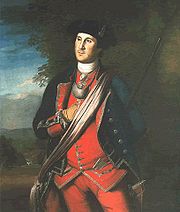
Virginia Regiment
Encyclopedia

Robert Dinwiddie
Robert Dinwiddie was a British colonial administrator who served as lieutenant governor of colonial Virginia from 1751 to 1758, first under Governor Willem Anne van Keppel, 2nd Earl of Albemarle, and then, from July 1756 to January 1758, as deputy for John Campbell, 4th Earl of Loudoun...
, initially as an all volunteer militia
Militia (United States)
The role of militia, also known as military service and duty, in the United States is complex and has transformed over time.Spitzer, Robert J.: The Politics of Gun Control, Page 36. Chatham House Publishers, Inc., 1995. " The term militia can be used to describe any number of groups within the...
corps, and he promoted George Washington
George Washington
George Washington was the dominant military and political leader of the new United States of America from 1775 to 1799. He led the American victory over Great Britain in the American Revolutionary War as commander-in-chief of the Continental Army from 1775 to 1783, and presided over the writing of...
, the future first president of the United States of America
President of the United States
The President of the United States of America is the head of state and head of government of the United States. The president leads the executive branch of the federal government and is the commander-in-chief of the United States Armed Forces....
, to its command upon the death of Colonel Joshua Fry
Joshua Fry
Colonel Joshua Fry was a surveyor, adventurer, mapmaker, soldier, and member of the House of Burgesses, the legislature of the colony of Virginia...
. Washington, who had previously been a lieutenant colonel
Lieutenant colonel
Lieutenant colonel is a rank of commissioned officer in the armies and most marine forces and some air forces of the world, typically ranking above a major and below a colonel. The rank of lieutenant colonel is often shortened to simply "colonel" in conversation and in unofficial correspondence...
of the Virginia militia
Virginia Militia
The Virginia militia is an armed force composed of all citizens of the Commonwealth of Virginia capable of bearing arms. The Virginia militia was established in 1607 as part of the British militia system. Militia service in Virginia was compulsory for all free males...
, received a promotion to colonel when he assumed command. The regiment served in the French and Indian War
French and Indian War
The French and Indian War is the common American name for the war between Great Britain and France in North America from 1754 to 1763. In 1756, the war erupted into the world-wide conflict known as the Seven Years' War and thus came to be regarded as the North American theater of that war...
, with members participating in actions (all under Washington's command) at Jumonville Glen
Battle of Jumonville Glen
The Battle of Jumonville Glen, also known as the Jumonville affair, was the opening battle of the French and Indian War fought on May 28, 1754 near what is present-day Uniontown in Fayette County, Pennsylvania...
and Fort Necessity in 1754, the Braddock expedition
Braddock expedition
The Braddock expedition, also called Braddock's campaign or, more commonly, Braddock's Defeat, was a failed British military expedition which attempted to capture the French Fort Duquesne in the summer of 1755 during the French and Indian War. It was defeated at the Battle of the Monongahela on...
in 1755, and the Forbes expedition in 1758. Small detachments of the regiment were also involved in numerous minor actions along Virginia's extensive wilderness frontier.
Most recruits were characterized by Washington as "loose, Idle Persons... quite destitute of House, and Home." Hampered by frequent desertions because of poor supplies, extremely low pay . and hazardous duty, Virginia Regiment recruiters went to Pennsylvania and Maryland
Province of Maryland
The Province of Maryland was an English and later British colony in North America that existed from 1632 until 1776, when it joined the other twelve of the Thirteen Colonies in rebellion against Great Britain and became the U.S...
for men. Washington also said of them, " and not a few... have Scarce a Coat, or Waistcoat, to their Backs". Later drafts pulled only those who could not provide a substitute or pay the £10 exemption fee, ensuring that only Virginia's poor would be drafted. White males between 16 and 50 were permitted to serve, although the regiment's size rolls report men as young as 15 and as old as 60 in the ranks, along with references to a small number of drafts with partial African and native American ancestry.
The Virginia Regiment is noteworthy in the colonies because it was the first all-colonial professional military force. Although colonials had served in the British Army, and local militias were common, the regiment was the only unit at the time to drill regularly and wear a standard uniform.
When Virginia ordered the creation of multiple regiments in 1775 with the outbreak of the American Revolutionary War
American Revolutionary War
The American Revolutionary War , the American War of Independence, or simply the Revolutionary War, began as a war between the Kingdom of Great Britain and thirteen British colonies in North America, and ended in a global war between several European great powers.The war was the result of the...
, these were called the Virginia Line
Virginia Line
The Virginia Line was a formation within the Continental Army. The term "Virginia Line" referred to the quota of numbered infantry regiments assigned to Virginia at various times by the Continental Congress. These, together with similar contingents from the other twelve states, formed the...
.

